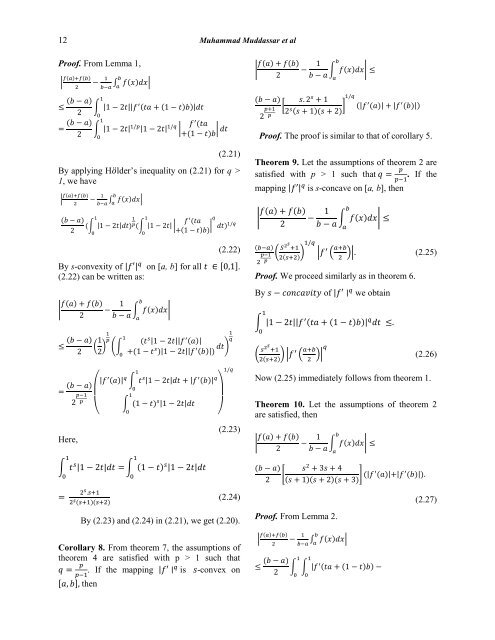TITLE MARCH 2012 - Pakistan Academy of Sciences
TITLE MARCH 2012 - Pakistan Academy of Sciences
TITLE MARCH 2012 - Pakistan Academy of Sciences
Create successful ePaper yourself
Turn your PDF publications into a flip-book with our unique Google optimized e-Paper software.
12 Muhammad Muddassar et al<br />
Pro<strong>of</strong>. From Lemma 1,<br />
Pro<strong>of</strong>. The pro<strong>of</strong> is similar to that <strong>of</strong> corollary 5.<br />
(2.21)<br />
By applying H lder’s inequality on (2.21) for q ><br />
1, we have<br />
Theorem 9. Let the assumptions <strong>of</strong> theorem 2 are<br />
satisfied with p > 1 such that . If the<br />
mapping<br />
is s-concave on [a, b], then<br />
(2.22)<br />
By s-convexity <strong>of</strong> on [a, b] for all .<br />
(2.22) can be written as:<br />
Pro<strong>of</strong>. We proceed similarly as in theorem 6.<br />
By <strong>of</strong> we obtain<br />
(2.25)<br />
(2.26)<br />
Now (2.25) immediately follows from theorem 1.<br />
Here,<br />
(2.23)<br />
Theorem 10. Let the assumptions <strong>of</strong> theorem 2<br />
are satisfied, then<br />
(2.24)<br />
By (2.23) and (2.24) in (2.21), we get (2.20).<br />
Pro<strong>of</strong>. From Lemma 2.<br />
(2.27)<br />
Corollary 8. From theorem 7, the assumptions <strong>of</strong><br />
theorem 4 are satisfied with p > 1 such that<br />
. If the mapping is -convex on<br />
then

















